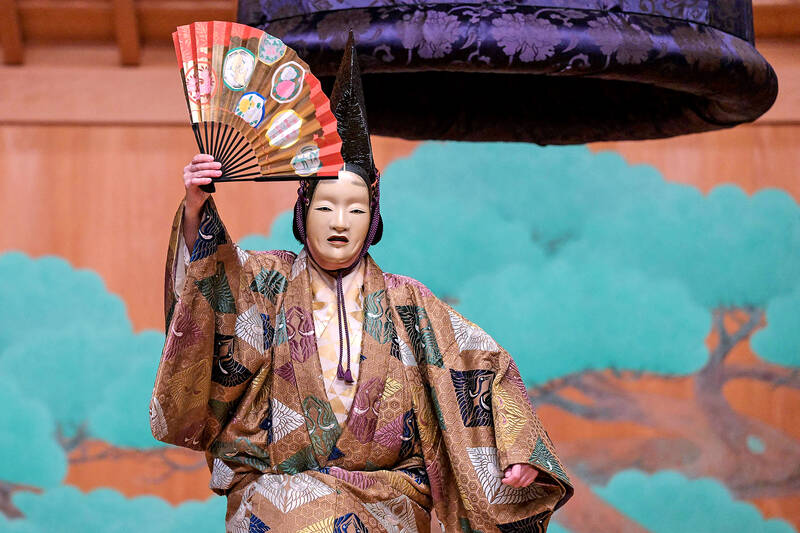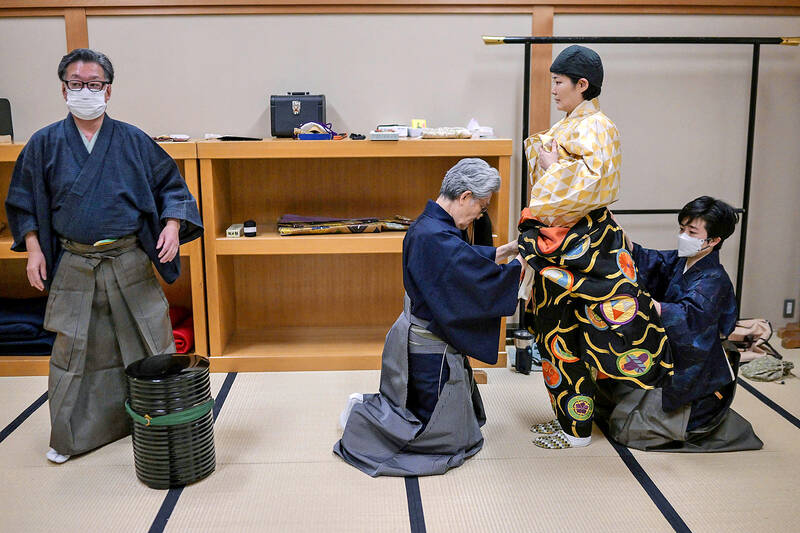Kimono-clad Mayuko Kashiwazaki delivers her lines in guttural tones and transforms into an evil snake in the lead role of a Japanese Noh play where, unusually, most of the cast are women.
Noh, with its elaborate layered costumes and hand-crafted masks, is one of the most ancient surviving forms of theatre, with origins dating back to the eighth century.
Unlike kabuki, another type of classical Japanese theater, or sumo wrestling — both steadfastly male — Noh has been open to performers of both genders for over a century.

Photo: AFP
But women are still a rarity in the traditional Noh world, where fathers often pass the vocation to their sons.
Women represent just 15 percent of the 1,039 actors and musicians registered with the professional Nohgaku Performers’ Association.
And their opportunities to appear on stage are “relatively limited,” 43-year-old Kashiwazaki said.

Photo: AFP
“One reason is that Noh audiences are generally older, and often see Noh as a masculine art form,” she said.
But now it’s time “for women to reflect on their future in Noh, and to play a role in building that future.”
Kashiwazaki acted the principal part in Dojoji, a famous drama about the revenge of a betrayed woman, at Tokyo’s National Noh Theater last weekend.
Twirling a fan, and wearing a heavy kimono embroidered with a crane motif, the masked actor belted out her lines in an archaic, warbling style as the story slowly unfolded.
After hiding under a prop representing the bell of a Buddhist temple, she emerged transformed as a demonic serpent character with wild, fiery tufts of red hair.
‘BEAUTY AND POWER’
Kashiwazaki, encouraged by her Noh mentor, tried to find as many women as possible to participate in the production.
“Dojoji is an extremely important piece for Noh actors,” Kashiwazaki said, and “you have to be very lucky to get a chance to perform it, even once in your life.”
“Because I was lucky enough to have this opportunity, I thought it would be great to stage it with other female Noh actors.”
Yoko Oyama, who played a handheld drum in the show, said it was unusual to see “so many women in the chorus and among the musicians on stage.”
“It’s not only the fact that they are women, but also that most of them are young for Noh performers, which makes the show even more special,” she said.
However, for some parts, including the supporting actor or “waki” in Noh — often a monk or priest character — there were no women to fill the role, so it was played by a man.
“There are no women performing waki... it has always been that way,” Kashiwazaki’s mentor, 72-year-old Yasuaki Komparu, told AFP.
While Komparu is the scion of one of five prominent Noh families that have bred generations of actors, Kashiwazaki first discovered Noh as a student.
She was charmed by its lyrical dramas and the heavily stylized acting in a minimal setting. A painting of a pine tree behind the stage is usually the only decoration.
“I was fascinated by how cool this Japanese art form looked, and thought I could only truly understand it by taking part myself,” she said.
‘VICIOUS CYCLE’
Kashiwazaki’s first mentor tried to dissuade her from becoming a Noh actor, having experienced herself the difficulties women face in the ancient art.
Now recognized by UNESCO as “intangible cultural heritage,” Noh developed towards its current form in Japan’s Muromachi era from 1336 to 1573, a period when the performers included women among their ranks.
In the Edo era from 1603 to 1868, patronage from shoguns helped Noh’s popularity grow.
But women were banned from the stage under government morality rules that repressed individual liberties.
Only at the end of the 19th century were women once again allowed to act in Noh, but they had to wait until 1948 to be recognized as professionals.
“There are extraordinary Noh actors, men and women, but the public tends to seek out a particular type of Noh, with a fixed idea of what it should be,” Kashiwazaki said.
That lack of opportunities creates a “vicious cycle” because actors can’t build up the experience to progress their careers, she said.
After Saturday’s show, audience member Kazuaki Ieda, 40, said he was “very interested and excited” by the performance.
“I think this may be the future of Noh in Japan,” Ieda said.

On April 26, The Lancet published a letter from two doctors at Taichung-based China Medical University Hospital (CMUH) warning that “Taiwan’s Health Care System is on the Brink of Collapse.” The authors said that “Years of policy inaction and mismanagement of resources have led to the National Health Insurance system operating under unsustainable conditions.” The pushback was immediate. Errors in the paper were quickly identified and publicized, to discredit the authors (the hospital apologized). CNA reported that CMUH said the letter described Taiwan in 2021 as having 62 nurses per 10,000 people, when the correct number was 78 nurses per 10,000

As we live longer, our risk of cognitive impairment is increasing. How can we delay the onset of symptoms? Do we have to give up every indulgence or can small changes make a difference? We asked neurologists for tips on how to keep our brains healthy for life. TAKE CARE OF YOUR HEALTH “All of the sensible things that apply to bodily health apply to brain health,” says Suzanne O’Sullivan, a consultant in neurology at the National Hospital for Neurology and Neurosurgery in London, and the author of The Age of Diagnosis. “When you’re 20, you can get away with absolute

May 5 to May 11 What started out as friction between Taiwanese students at Taichung First High School and a Japanese head cook escalated dramatically over the first two weeks of May 1927. It began on April 30 when the cook’s wife knew that lotus starch used in that night’s dinner had rat feces in it, but failed to inform staff until the meal was already prepared. The students believed that her silence was intentional, and filed a complaint. The school’s Japanese administrators sided with the cook’s family, dismissing the students as troublemakers and clamping down on their freedoms — with

As Donald Trump’s executive order in March led to the shuttering of Voice of America (VOA) — the global broadcaster whose roots date back to the fight against Nazi propaganda — he quickly attracted support from figures not used to aligning themselves with any US administration. Trump had ordered the US Agency for Global Media, the federal agency that funds VOA and other groups promoting independent journalism overseas, to be “eliminated to the maximum extent consistent with applicable law.” The decision suddenly halted programming in 49 languages to more than 425 million people. In Moscow, Margarita Simonyan, the hardline editor-in-chief of the